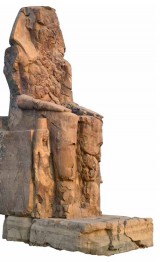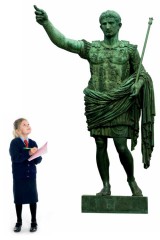Dr Tim Lomas outlines a successful approach to historical enquiry that will stop children copying chunks out of text books...
So often one hears the complaint about primary history – too much imparting of content and not enough investigation. In fact, the two approaches have, in the minds of many, become direct opposites with enquiry being a good thing and the imparting of factual information a bad thing. In reality, one cannot exist without the other and an enquiry approach with primary history can be a disaster if handled badly.
Just setting pupils a question to investigate is not a good enquiry. On one occasion, I witnessed the teacher set a class of Y4 pupils the question, “Find out all you can about the Romans”. If anything was designed to lead to unthinking downloading or copying then this was it.
There are two important prerequisites for successful investigations in primary history. Firstly, the need to develop the skills that will enable pupils to engage with the enquiry. Secondly, the need to set manageable, motivating and worthwhile enquiry questions.
Below are several good activities that can be used to help develop enquiry skills:
 • Provide a historical story with a missing section, or with a deliberate error. The pupils have to research the events and compose the missing part of the story or correct the mistakes. This is much more manageable than a full-scale broad enquiry.
• Provide a historical story with a missing section, or with a deliberate error. The pupils have to research the events and compose the missing part of the story or correct the mistakes. This is much more manageable than a full-scale broad enquiry.
• Pupils pose a set of questions themselves to help guide their enquiry. One useful approach is to get them to consider a central question followed by sub-questions which feed this main question.
• Organise resources in such a way that the question cannot be answered without using parts from different sources. This stops children copying huge chunks from one source.
• Provide pupils with access to materials, but make sure they have to write up their findings without notes or the resources. This means pupils will concentrate on digesting the information and the key features.
• Pupils have to adapt the format of the materials: write in the first person, convert text into a diagram, write from another viewpoint, adapt for a different audience.
• Design, or allow pupils to design, investigation sheets with headings such as “main point”, “main reasons”, “supporting evidence”, “sources of information”.
These types of activities allow pupils to develop research and organisational skills in a manageable and enjoyable way. They will also improve their grasp of concepts such as evidence and interpretations. For example, seeing that different sources can provide a different slant on an issue - or contradict each other – will help pupils improve their understanding of the historical process.
With the youngest pupils, it is important not to be too challenging. They might focus on matters such as finding a particular piece of information about some specific event. Alternatively, children could organise a collection of sources into a coherent response, such as sorting cards or pictures.
 As pupils progress through the primary years, they should be able to cope with more sophisticated enquiry work, pursuing several or all of the processes involved in historical investigation. Teachers may want to set tasks that make children more competent at:
As pupils progress through the primary years, they should be able to cope with more sophisticated enquiry work, pursuing several or all of the processes involved in historical investigation. Teachers may want to set tasks that make children more competent at:
• starting an enquiry – discussing what makes it valid and worthwhile, how they might pursue it in terms of resources, themes, questions and how it might be pursued in the time available;
• selecting and organising relevant material, including the use of conventions such as indexes and other references;
• thinking about relevance and evaluating the quality and reliability of information for the questions being answered;
• ordering and ranking material and refining the questions in the light of evidence obtained. This will involve establishing sequences, connections and relationships;
• organising material so that the central issues stand out from the less significant points;
• communicating information accurately in appropriate and varied styles so that it is relevant, efficient, substantiated, balanced, tentative and clear.
 How might this work in practice? The example below is a local history enquiry – another aspect given a stronger emphasis in the revised curriculum.
How might this work in practice? The example below is a local history enquiry – another aspect given a stronger emphasis in the revised curriculum.
The teacher may want firstly to set a valid, manageable and openended investigation. For instance, if the class has been studying the Victorians, a parallel local investigation could look into how pleasant life was for the local community at that time. The following activities might then be carried out:
• the whole class share ideas on what they might want to investigate – the rich, the poor, children etc. The teacher might suggest that there would not be enough time to cover all these so the class could narrow the scope of their enquiry – perhaps, in this case - to Victorian children;
• pupils could then work out what aspects they would like to investigate about Victorian childhood. Again, manageability needs to be encouraged. Possible themes might be the difference between rich and poor, home life, school, health, child workers and leisure. Children might also consider where they might find the information; perhaps being directed to books, worksheets, specific websites and some archival sources such as newspapers, photographs, school log books, paintings, census or commissions on child labour;
• pupils then investigate these questions or issues. The class could be divided up with each group enquiring on a specific aspect. For example, one group might probe Victorian schools by looking at some paintings, examining an extract from a novel, or sifting through school log and punishment books. It is important that each group is given clear parameters such as what they need to prepare. They might even collate their information on a template that has sections, i.e. evidence for and against school being pleasant, explanation, reliability and completeness of the evidence, overall judgement and conclusion;
• the class would decide how they want to communicate their findings. They might prepare a class pageant or display, or else compile a folder with each group contributing their own section;
• an important aspect would be bringing everything together in the final stages and checking understanding. This could involve children quizzing a research group on their theme. The teacher might also ask some questions that cause pupils to consider the significance of their work such as: Was childhood unpleasant for all Victorians? Did things improve as the 19th century progressed? Was the local area probably better or worse than elsewhere? Are there some aspects they would like to have investigated to help produce a fuller answer? Overall, do the class feel that life was unpleasant for Victorian children?
The above approaches demonstrate clearly that enquiry in primary history involves much more than just gathering material in a random way. Success depends on developing the requisite skills and carefully organising the activities to permit meaningful investigations in the time available. Above all it requires thinking of enquiry questions that pupils want to answer, and will readily do so even though it will involve them in some hard thinking. Tim Lomas is Principal School Improvement Adviser for the Lincolnshire School Improvement Service and Vice President of the Historical Association.
How children react to a moral dilemma may be down to your teaching
Ace-Classroom-Support
